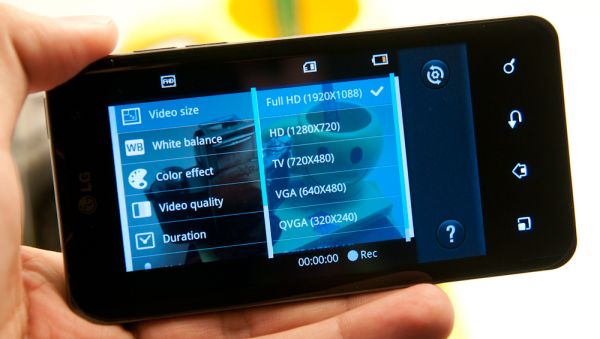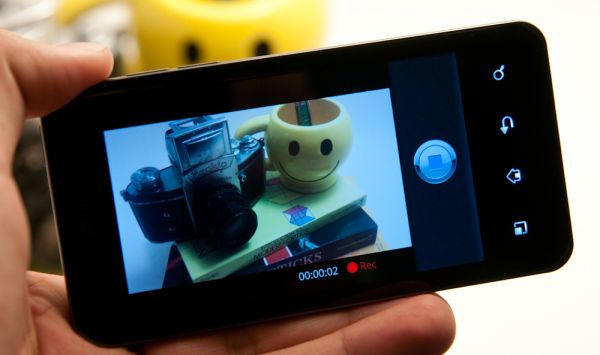LG Optimus 2X & NVIDIA Tegra 2 Review: The First Dual-Core Smartphone
by Brian Klug & Anand Lal Shimpi on February 7, 2011 3:53 AM EST- Posted in
- Smartphones
- Tegra 2
- LG
- Optimus 2X
- Mobile
- NVIDIA
Video Capture
The other big part of the 2X is that it’s the first smartphone to do H.264 1080P video capture. We took the 2X out to our usual test site and recorded video on the 2X at every quality setting at 1080p, and at maximum quality at 720P and VGA resolutions, and one final video with the front facing camera. I looked at the videos and then had Ganesh, our resident media center and video expert, as well as Anand take a look at the same original videos and compare to our other devices. It’s hard to argue that the iPhone 4 and Nokia N8 aren’t the devices to beat, both of them cranking out impressively sharp 720P video. We’ve done the usual thing and uploaded all the test videos to YouTube in addition to making a big zip for comparison in their original glory—links are in the table below.
Before we get to our comparison, a little background. First off, the 2X records 1920x1088 video in H.264 Baseline profile at an average of around 12 Mbps, audio is 1 channel AAC at 64 Kbps. The specifications for the 2x say 1080p24, in practice I’ve seen some framerate variability between 24 and 30 depending on lighting conditions. These videos are close to but not exactly 30 FPS, two videos I shot with the 2X at CES are clearly 24 FPS. Why the extra 8 pixels of vertical resolution, you might be wondering? The reason is simple—1088 is an even factor of 16, and macroblocks are 16x16 pixels.
| LG Optimus 2X Video Capture Samples | |||||
| Rear Facing 8 MP Camera |
1080P—SuperFine 1080P—Fine 1080P—Normal 720P—SuperFine 480P—SuperFine |
||||
| Front Facing 1.3 MP Camera | VGA—SuperFine | ||||
| LG Optimus 2X vs iPhone 4 at 720P | Mashup—YouTube, MP4 (zip), iPhone 720P (zip) | ||||
| LG Optimus 2X Original Videos | Original Videos (153.6 MB zip) | ||||
So how does 1080p24 video shot on the 2X compare to the iPhone 4 and Nokia N8? Unfortunately, not all that well. At 1080P there’s noticeable softness and loss of high spatial frequency detail. At about the 3 second mark in the first video I took (1080p at Super Fine) there’s also some noticeable glare from light flaring off of the glass surface between the camera’s last vertex and the plastic battery door. It’s that kind of stuff that’s a bit frustrating to still see going on with smartphones. The video has noticeable macro-blocking artifacts in the dark regions as well, which is disappointing. Though the Tegra 2 ISP is competent as shown by still image quality, clearly the video encode engine needs a bit more work. SuperFine as we already mentioned corresponds to around 12 Mbps, Fine corresponds to 8.5 Mbps, Normal quality seems to hover around 6 Mbps. You can fit a little over an hour of SuperFine quality 1080P video on the user-accessible 6 GB partition of the 2X’s 8 GB internal storage.
The obvious comparison really is at 720P, where we can directly compare the 2X’s video quality to the N8 and iPhone 4. I don’t have the N8 anymore, our comparison video is still what’s in bench. I do still have an iPhone 4, and captured a video taken at the exact same time as the 2X held carefully above the other phone. You can view both for yourself or compare with a mashup I put together showing both at the same time. The video I made showing both has a bit of downscaling and is at 30 FPS (so the 2X video occasionally looks like it’s dropping frames when it really isn’t), but still illustrates the differences.
Watching both at the same time, it’s readily apparent that the iPhone 4 does a noticeably better job with high frequency spatial detail, where the 2X seems to have softening. The 2X does do a better job with the dark areas of the intersection when panning back, but there’s still macroblocking visible. It’s obvious that there’s a combination of encoder and optics holding the 2X back from having dramatically higher quality video.












75 Comments
View All Comments
GoodRevrnd - Tuesday, February 8, 2011 - link
TV link would be awesome, but why would you need the phone to bridge the TV and network??aegisofrime - Monday, February 7, 2011 - link
May I suggest x264 encoding as a test of the CPU power? There's a version of x264 available for ARM chips, along with NEON optimizations. Should be interesting!Shadowmaster625 - Monday, February 7, 2011 - link
What is the point in having a high performance video processor when you cannot do the two things that actually make use of it? Those two things are: 1. Watch any movie in your collection without transcoding? (FAIL) 2. Play games. No actual buttons = FAIL. If you think otherwise then you dont actually play games. Just stick with facebook flash trash.TareX - Wednesday, February 9, 2011 - link
The only reason I'd pay for a dual core phone is smooth flash-enabled web browsing, not gaming.zorxd - Monday, February 7, 2011 - link
Stock Android has it too. There is also E for EDGE and G for GPRS.Exophase - Monday, February 7, 2011 - link
Hey Anand/Brian,There are some issues I've found with some information in this article:
1) You mention that Cortex-A8 is available in a multicore configuration. I'm pretty sure there's no such thing; you might be thinking of ARM11MPCore.
2) The floating point latencies table is just way off for NEON. You can find latencies here:
http://infocenter.arm.com/help/index.jsp?topic=/co...
It's the same in Cortex-A9. The table is a little hard to read; you have to look at the result and writeback stages to determine the latency (it's easier to read the A9 version). Here's the breakdown:
FADD/FSUB/FMUL: 5 cycles
FMAC: 9 cycles (note that this is because the result of the FMUL pipeline is then threaded through the FADD pipeline)
The table also implies Cortex-A9 adds divide and sqrt instructions to NEON. In actuality, both support reciprocal approximation instructions in SIMD and full versions in scalar. The approximation instructions have both initial approximation with ~9 bits of precision and Newton Rhapson step instructions. The step instructions function like FMACs and have similar latencies. This kind of begs the question of where the A9 NEON DIV and SQRT numbers came from.
The other issue I have with these numbers is that it only mentions latency and not throughput. The main issue is that the non-pipelined Cortex-A8 FPU has throughput almost as bad as its latency, while all of the other implementations have single cycle throughput for 2x 64-bit operations. Maybe throughput is what you mean by "minimum latency", however this would imply that Cortex-A9 VFP can't issue every cycle, which isn't the case.
3) It's obvious from the GLBenchmark 2.0 Pro screenshot that there are some serious color limitations from Tegra 2 (look at the woman's face). This is probably due to using 16-bit. IMG has a major advantage in this area since it renders at full 32-bit (or better) precision internally and can dither the result to 16-bit to the framebuffer, which looks surprisingly similar in quality to non-dithered 32-bit. This makes a 16-bit vs 16-bit framebuffer comparison between the two very unbalanced - it's far more fair to just do both at 32-bit, but it doesn't look like the benchmark has any option for it. Furthermore, Tegra 2 is limited to 16-bit (optionally non-linear) depth buffers, while IMG utilizes 32-bit floating point depth internally. This is always going to be a disadvantage for Tegra 2 and is definitely worth mentioning in any comparison.
Finally I feel like ranting a little bit about your use of the Android Linpack test. Anyone with a little common sense can tell that a native implementation of Linpack on these devices will yield several dozen times more than 40MFLOPS (should be closer to 1-4 FLOP/CPU cycle). What you see here is a blatant example of Dalvik's extreme inability to perform with floating point code that extends well beyond an inability to perform SIMD vectorization.
metafor - Monday, February 7, 2011 - link
According to the developer of Linpack on Android:http://www.greenecomputing.com/category/android/
It is mostly FP64 calculations done on Dalvik. While this may not be the fastest way to go about doing linear algebra, it is a fairly good representation of relative FP64 performance (which only exist in VFP).
And let's face it, few app developers are going to dig into Android's NDK and write NEON optimized code.
Exophase - Monday, February 7, 2011 - link
Then let's ask this instead: who really cares about FP64 performance on a smartphone? I'd also argue that it is not even a good representation of relative FP64 performance since that's being obscured so much by the quality of the JITed code. Hence why you see Scorpion and A9 perform a little over twice as fast as A8 (per-clock) instead of several times faster. VFP is still in-order on Cortex-A9, competent scheduling matters.Maybe a lot of developers won't write NEON code on Android, but where it's written it could very well matter. For one thing, in Android itself. And theoretically one day Dalvik could actually be generating NEON competently.. so some synthetic tests of NEON could be a good look at what could be.
metafor - Monday, February 7, 2011 - link
Well, few people really :)Linpack as it currently exists on Android probably doesn't tell very much at all. But if you're just going to slap together an FP heavy app (pocket scientific computing anyone?) and aren't a professional programmer, this likely represents the result you see.
I wouldn't mind seeing SpecFP ported natively to Android and running NEON. But alas, we'd need someone to roll up their sleeves and do that.
I did do a native compile of Linpack using gcc to test on my Evo, though. It's still not SIMD code, of course, but native results using VFP were around the 70-80MFLOPS mark. Of course, it's scheduling for the A8's FPU and not Scorpion's.
Anand Lal Shimpi - Monday, February 7, 2011 - link
Thanks for your comment :)1) You're very right, I was thinking about the ARM11 - fixed :)
2) Make that 2 for 2. You're right on the NEON values, I mistakenly grabbed the values from the cycles column and not the result column. The DIV/SQRT columns were also incorrect, I removed them from the article.
I mentioned the lack of pipelining in the A8 FPU earlier in the article but I reiterated it underneath the table to hammer the point home. I agree that the lack of pipelining is the major reason for the A8's poor FP performance.
3) Those screenshots were actually taken on IMG hardware. IMG has some pretty serious rendering issues running GLBenchmark 2.0.
4) I'm not happy with the current state of Android benchmarks - Linpack included. Right now we're simply including everything we can get our hands on, but over the next 24 months I think you'll see us narrow the list and introduce more benchmarks that are representative of real world performance as well as contribute to meaningful architecture analysis.
Take care,
Anand